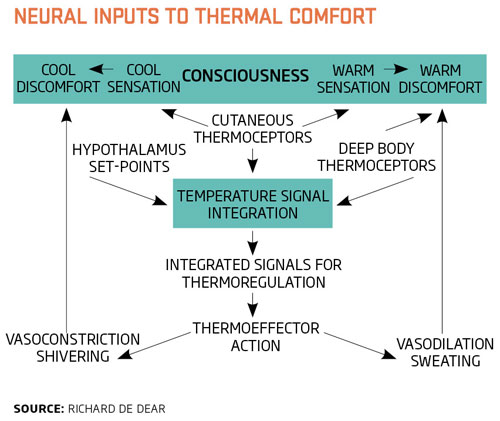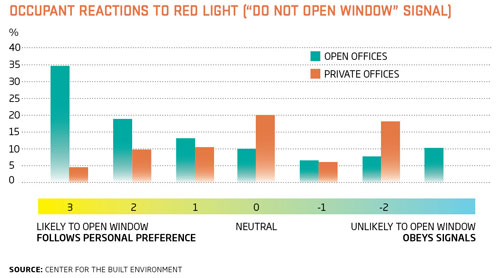The Comfort Zone
Although Paliaga acknowledges that occupants in mixed-mode buildings likely experience some degree of psychological adaptation beyond the behavioral adjustments incorporated into the PMV model, he explains that, for now, "we can't include mixed-mode buildings in Standard 55's optional method, because the studies on these types of buildings have yet to be done."
Although section 5.3 may be incremental in scope, its inclusion in ASHRAE is significant. Not too long after ASHRAE acknowledged the adaptive theory with its 2004 version of Standard 55, the European community included an adaptive section in European Standard EN15251--"Indoor environmental input parameters for design and assessment of energy performance of buildings addressing indoor air quality, thermal environment, lighting and acoustics," published in 2007. Humphreys reports that, although it is still in the discussion stages, the thermal comfort standard that the Chinese are currently trying to establish is "largely adaptive in concept."
Going Forward
While proponents of adaptive thermal comfort welcome these advances as incremental steps toward reshaping the heating, ventilation, and air-conditioning practices that developed during a period of energy abundance into more sustainable approaches for a society facing peak oil, there is no doubt that there is still much more to learn within this multidisciplinary field, which sits at the crossroads of physics, physiology, psychology, culture, and climate.
Zooming down to the cellular level, for example, consider, the paper "Thermal Comfort in Natural Ventilation-A Neurophysiological Hypothesis," which was presented by Richard de Dear at the April 2010 Windsor conference. In it, de Dear explores the physiological phenomenon known as alliesthesia, a term coined by French physiologist Michel Cabanac in 1971 "to describe the phenomenon whereby a given stimulus can induce either a pleasant, or unpleasant sensation, depending on the subject's internal state." Research conducted at this physiological level suggests that humans may actually prefer experiencing a change towards a desired state more than experiencing the desired state itself. Like a diner who enjoys the act of eating more than the state of being full, a slightly overheated occupant may report being more comfortable when sensing a mild breeze that promises to cool him or her down to the desired temperature than when the desired, or "thermally neutral," temperature is actually achieved and statically maintained. At the end of the paper de Dear suggests that, "we need to understand allesthesia…to create thermal…comfort or even better, thermal delight."
|
Â
In contrast, zooming up to the scale of a building, consider yet another study recently undertaken by Katie Ackerly, a student in the Master of Science in Architecture program at University of California Berkeley, under the guidance of Brager, now associate director of the Center for the Built Environment at Berkeley (CBE) and CBE Director of Communications David Lehrer. Ackerly has been analyzing more than a dozen mixed-mode office buildings in the United States that were equipped with window-signaling systems that are intended to educate and motivate occupants to adjust the windows when such action is warranted. The goal is to understand how to optimize the window-control behavior of multiple occupants in conjunction with a building's mechanical system so that the individual's control of his or her personal environment -and therefore his or her comfort level--is maximized while any discomfort to others is minimized, hopefully along with reducing the building's overall energy bill.
|
Â
Clearly, these and many other types of empirical studies need to be carried out before designers can confidently create a built environment that can truly stay in sync with all its complex and dynamic human occupants. Until then, maybe a little bit of humility and basic common sense is in order.










